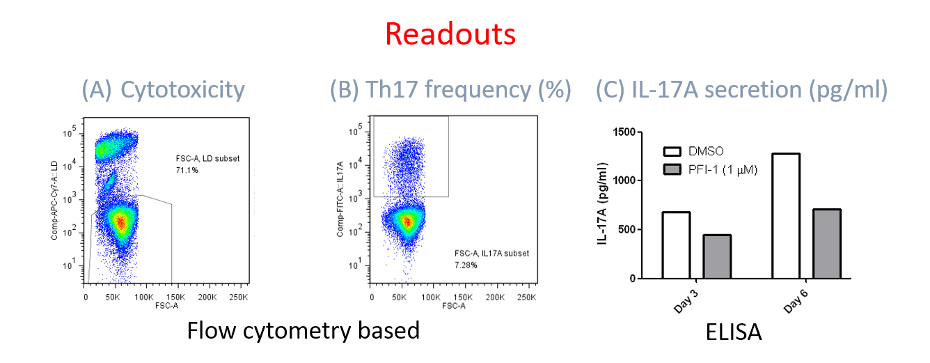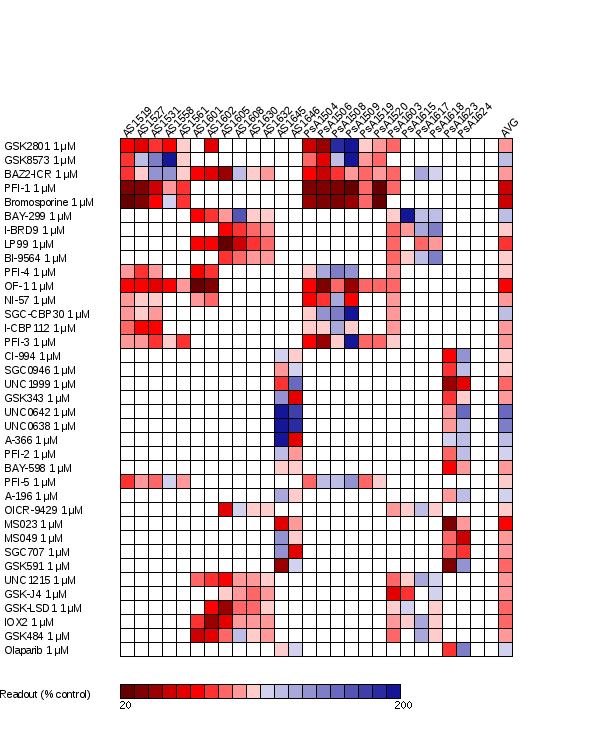Th17 differentiation assay - % Th17 & IL-17A production
In support of genetic data genetics (which implicates type 17 related genes), the strongest biologic factor reported to be associated with AS is IL-17 and type 3 immunity. IL-17A was found to be elevated in serum, synovial fluid, joints and CD4+ (TH17) cells from patients with AS(1, 2).
To identify probes and pathways that regulate generation of Th17 cells or downregulate production of IL-17A from CD4 T cells from AS patient peripheral blood
Aside from BET & CREBBP/EP300 bromodomain inhibitors already demonstrated to reduce IL-17A and Th17 axis (3), the BRPF inhibitor OF-1 shows strongest potential for inhibiting IL-17A and % Th17 cells (CD4+ T cells producing IL-17A), an established therapeutic target in AS & PsA (4, 5).
- PBMCs were isolated from whole blood from SpA patients using Histopaque and rested overnight at 37oC/5% CO2.
- CD4+ T cells were then isolated by Miltenyi Biotec negative selection kit and plated in a U bottom 96 well plate in 200 µl RPMI 1640 containing 10% FBS and glutamine.
- IL-2, Th17-skewing cytokines and T cell expander beads were added.
- 1 µM probes or DMSO as a negative control were also added (d0).
- At day 3, 100 µl of culture supernatant was removed and 100 µl of fresh probes in culture media with cytokines was added.
- On day 6, cells were spun down and supernatants collected and frozen for quantification of IL-17A by ELISA.
- For intracellular cytokine staining, the remaining cells were stimulated with PMA/ionomycin plus brefeldin A and monensin for 4 hrs, then surface staining for CD3, CD4, CD8 and live/dead staining was carried out.
- Cells were washed, fixed and permeabilised. Permeabilised cells were then labeled with antibodies to IL-17A and IFNg, then analysed on BD Calibur Fortessa.
- Collect 20ml of blood from SpA patient
- Isolate whole PBMCs, rest overnight
- CD4+ T cell negative isolation
- Culture of CD4+ T cells under Th17-skewing condition for 6 days plus expander beads
- Probes added from day 0, and replenished at day 3
- At day 6, harvest cells for FACS (Th1, Th2, Th17) and collect supernatant for ELISA (IL-17A).

Patient T cells were cultured as described and cells were analysed by flow cytometry and elisa to assess cytotoxicity induced by the probes (A), Th17 frequency (B), and levels of IL-17A production (C). Cytotoxicity was detected by positive live/dead staining, with dead cells excluded from analysis for % Th17 cells.
IL-17A production from probe treated SpA patient T cells

AS (AS prefix) or PsA (PS prefix) patient T cells were cultured according to the described protocol and IL-17A production was measured in the culture supernatants. Results are normalized to the negative DMSO control for each donor. The final column is the relative mean of all donors.
% Th17 cells from probe treated SpA patient T cells

AS (AS prefix) or PsA (PS prefix) patient T cells were cultured according to the described protocol and %Th17 cells (CD4+, IL-7A+) was enumerated by flow cytometry. Results are normalized to the negative DMSO control for each donor. The final column is the relative mean of all donors.
- Mei, Y., Pan, F., Gao, J., Ge, R., Duan, Z., Zeng, Z., Liao, F., Xia, G., Wang, S., Xu, S., Xu, J., Zhang, L., and Ye, D. (2011) Increased serum IL-17 and IL-23 in the patient with ankylosing spondylitis, Clin. Rheumatol. 30, 269-273.
- Shen, H., Goodall, J. C., and Hill Gaston, J. S. (2009) Frequency and phenotype of peripheral blood Th17 cells in ankylosing spondylitis and rheumatoid arthritis, Arthritis Rheum. 60, 1647-1656.
- Hammitzsch, A., Tallant, C., Fedorov, O., O'Mahony, A., Brennan, P. E., Hay, D. A., Martinez, F. O., Al-Mossawi, M. H., de Wit, J., Vecellio, M., Wells, C., Wordsworth, P., Muller, S., Knapp, S., and Bowness, P. (2015) CBP30, a selective CBP/p300 bromodomain inhibitor, suppresses human Th17 responses, Proc. Natl. Acad. Sci. U. S. A. 112, 10768-10773.
- Koenders, M. I., and van den Berg, W. B. (2016) Secukinumab for rheumatology: development and its potential place in therapy, Drug design, development and therapy 10, 2069-2080.
- Paine, A., and Ritchlin, C. T. (2016) Targeting the interleukin-23/17 axis in axial spondyloarthritis, Curr. Opin. Rheumatol. 28, 359-367.




